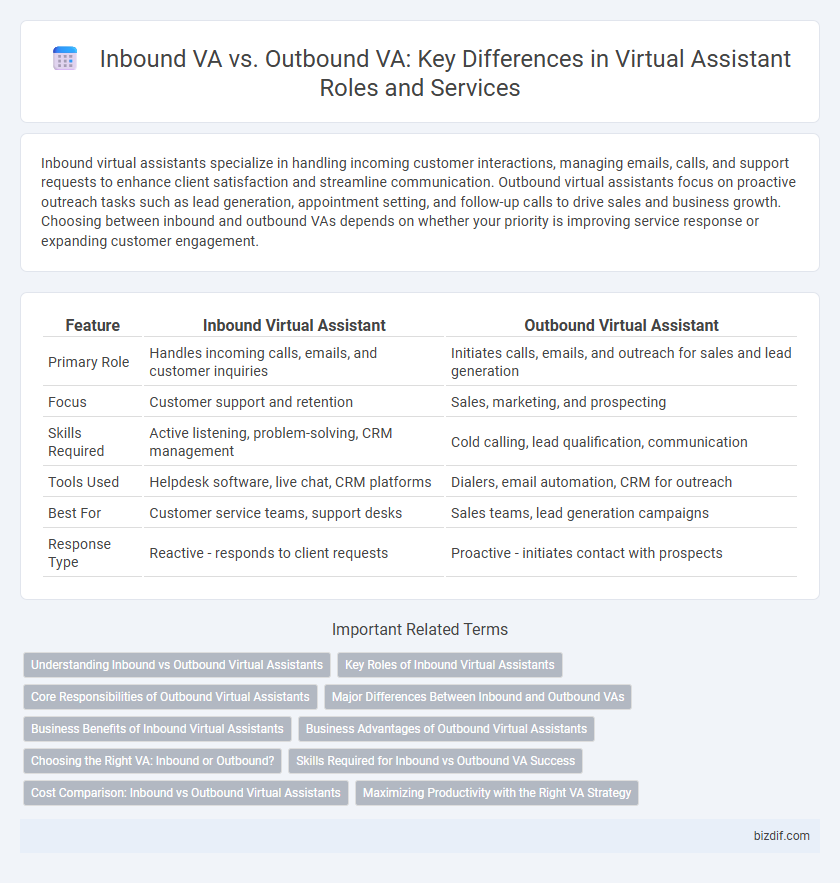Inbound virtual assistants specialize in handling incoming customer interactions, managing emails, calls, and support requests to enhance client satisfaction and streamline communication. Outbound virtual assistants focus on proactive outreach tasks such as lead generation, appointment setting, and follow-up calls to drive sales and business growth. Choosing between inbound and outbound VAs depends on whether your priority is improving service response or expanding customer engagement.
Table of Comparison
| Feature | Inbound Virtual Assistant | Outbound Virtual Assistant |
|---|---|---|
| Primary Role | Handles incoming calls, emails, and customer inquiries | Initiates calls, emails, and outreach for sales and lead generation |
| Focus | Customer support and retention | Sales, marketing, and prospecting |
| Skills Required | Active listening, problem-solving, CRM management | Cold calling, lead qualification, communication |
| Tools Used | Helpdesk software, live chat, CRM platforms | Dialers, email automation, CRM for outreach |
| Best For | Customer service teams, support desks | Sales teams, lead generation campaigns |
| Response Type | Reactive - responds to client requests | Proactive - initiates contact with prospects |
Understanding Inbound vs Outbound Virtual Assistants
Inbound virtual assistants specialize in managing incoming communications such as customer support calls, emails, and live chat inquiries, ensuring prompt and effective responses to client needs. Outbound virtual assistants focus on proactive outreach tasks including sales calls, follow-ups, and lead generation to drive business growth. Understanding the distinction between inbound and outbound virtual assistants allows companies to optimize their staffing strategies based on service type and operational goals.
Key Roles of Inbound Virtual Assistants
Inbound virtual assistants specialize in managing incoming communications such as customer support calls, emails, and live chat inquiries to ensure timely and effective responses. They often handle appointment scheduling, order processing, and troubleshooting to enhance customer satisfaction and streamline business operations. Expertise in CRM software and strong communication skills are essential for inbound VAs to efficiently address customer needs and maintain positive client relationships.
Core Responsibilities of Outbound Virtual Assistants
Outbound Virtual Assistants specialize in proactive client engagement tasks such as lead generation, cold calling, and follow-up communication to convert prospects into customers. They manage outbound email campaigns, schedule appointments, and conduct market research to support business development efforts. Core responsibilities emphasize initiating contact and driving sales, distinguishing them from Inbound VAs who primarily handle incoming requests and customer support.
Major Differences Between Inbound and Outbound VAs
Inbound virtual assistants specialize in handling incoming client communications such as customer support, email management, and appointment scheduling, ensuring efficient response and customer satisfaction. Outbound virtual assistants focus on proactive tasks like lead generation, cold calling, and sales outreach to drive business growth and client acquisition. The primary difference lies in inbound VAs managing reactive tasks while outbound VAs execute proactive engagement strategies.
Business Benefits of Inbound Virtual Assistants
Inbound virtual assistants enhance customer satisfaction by efficiently managing incoming calls, emails, and inquiries, leading to faster response times and improved client retention. They streamline business operations by handling order processing, appointment scheduling, and technical support, allowing companies to focus on core activities. Utilizing inbound VAs reduces overhead costs and scales customer support without the need for extensive in-house staff.
Business Advantages of Outbound Virtual Assistants
Outbound Virtual Assistants drive business growth by proactively reaching out to potential clients, increasing lead generation and sales opportunities. They efficiently handle cold calling, follow-ups, and appointment setting, freeing up in-house teams to focus on core operations. These VAs enhance customer engagement and brand visibility through targeted outreach strategies tailored to business goals.
Choosing the Right VA: Inbound or Outbound?
Choosing the right virtual assistant depends on your primary business needs: inbound VAs specialize in handling incoming customer inquiries, support tickets, and managing communication channels, ensuring prompt and efficient customer service. Outbound VAs focus on lead generation, cold calling, appointment setting, and follow-ups, driving sales and expanding business opportunities. Evaluate your goals to determine whether enhancing customer support or boosting outreach efforts will deliver the most value.
Skills Required for Inbound vs Outbound VA Success
Inbound virtual assistants require exceptional communication skills, active listening, and problem-solving abilities to manage customer inquiries and provide timely support. Outbound virtual assistants excel in persuasive communication, lead generation, and sales techniques to effectively engage prospects and drive conversions. Both roles demand proficiency in CRM software and multitasking to ensure seamless workflow and client satisfaction.
Cost Comparison: Inbound vs Outbound Virtual Assistants
Inbound virtual assistants typically incur lower costs due to predictable workloads focused on customer support, scheduling, and data entry, requiring fewer specialized skills. Outbound virtual assistants demand higher fees because they handle proactive tasks like lead generation, appointment setting, and sales outreach, which require advanced communication and sales expertise. Companies often weigh cost against value, finding inbound VAs ideal for operational efficiency while outbound VAs drive revenue growth despite higher expenses.
Maximizing Productivity with the Right VA Strategy
Inbound virtual assistants specialize in managing customer inquiries, scheduling, and support tasks, ensuring efficient handling of incoming communication and boosting response times. Outbound virtual assistants focus on proactive tasks such as lead generation, follow-ups, and marketing outreach, driving business growth through targeted engagement. Selecting the right VA strategy by matching inbound support with outbound outreach optimizes overall productivity and enhances operational efficiency.
Inbound VA vs Outbound VA Infographic

 bizdif.com
bizdif.com